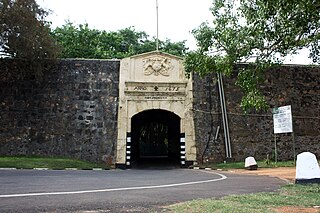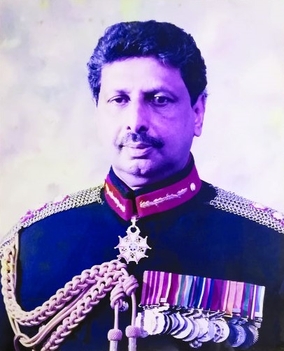
The Sri Lankan civil war was a civil war fought in Sri Lanka from 1983 to 2009. Beginning on 23 July 1983, it was an intermittent insurgency against the government by the Liberation Tigers of Tamil Eelam led by Velupillai Prabhakaran. The LTTE fought to create an independent Tamil state called Tamil Eelam in the north-east of the island, due to the continuous discrimination and violent persecution against Sri Lankan Tamils by the Sinhalese-dominated Sri Lanka government.

Fort Fredrick, also known as Trincomalee Fort or Fort of Triquillimale, is a fort built by the Portuguese at Trincomalee, Eastern Province, Sri Lanka, completed in 1624 CE, built on Swami Rock-Konamamalai from the debris of the world-famous ancient Hindu Koneswaram temple. The temple was destroyed by the Portuguese colonial Constantino de Sá de Noronha under Phillip III, occupier of the Jaffna kingdom and Malabar country on the island. On the Konamalai cape was also built a new village of Portuguese and Tamil people, 50 Portuguese soldiers and inside the fort, a church named after "Nossa Senhora de Guadalupe". The Fort of Triquillimale was dismantled and rebuilt by the Dutch in 1665, renamed Fort Fredrick.

The Vadamarachchi Operation Medal was a campaign medal presented to all ranks of the regular and volunteer forces of the Military of Sri Lanka that served in the Vadamarachchi Operation, the last major campaign carried out by the Sri Lankan military as part of Eelam War I before the arrival of the Indian Peace Keeping Force in Sri Lanka. The award was also awarded to civilians that aided in the operation.
Eelam War III is the name given to the third phase of armed conflict between the Sri Lankan military and the separatist Liberation Tigers of Tamil Eelam (LTTE).

Eelam War IV is the name given to the fourth and final phase of armed conflict between the Sri Lankan military and the separatist Liberation Tigers of Tamil Eelam (LTTE). Renewed hostilities began on the 26 July 2006, when Sri Lanka Air Force fighter jets bombed several LTTE camps around Mavil Aru anicut. The government's casus belli was that the LTTE had cut off the water supply to surrounding paddy fields in the area. Shutting down the sluice gates of the Mavil Aru on July 21 depriving the water to over 15,000 people - Sinhalese and Muslim settlers under Sri Lankan state-sponsored colonisation schemes in Trincomalee district. They were denied of water for drinking and also cultivating over 30,000 acres of paddy and other crops. The fighting resumed after a four-year ceasefire between the Government of Sri Lanka (GoSL) and LTTE. Continued fighting led to several territorial gains for the Sri Lankan Army, including the capture of Sampur, Vakarai and other parts of the east. The war took on an added dimension when the LTTE Air Tigers bombed Katunayake airbase on March 26, 2007, the first terrorist air attack without external assistance in history.

The Eastern Theatre of Eelam War IV started in the Eastern province of Sri Lanka on July 21, 2006, when the LTTE cut off the water supply to rice fields in eastern Trincomalee district. The government claimed total control of the Eastern province after capturing Thoppigala on July 11, 2007, after nearly a year of fighting. Major battles took place at Sampoor, Vakarai, Kanchikudicharu, Kokkadichloai and Thoppigala. Military and civilian deaths were relatively low on both sides. Government forces captured much military hardware from the LTTE during the conflict. The civilians managed to flee the combat zones, and this reduced civilian casualties, while swelling the number of internally displaced people (IDP). The world health organization (WHO) estimated ~200,300 IDPs, and claims that significant progress occurred in resettling them. The LTTE vowed to attack Sri Lanka's military and economic targets across the country to retaliate for the capture of the Eastern province from them. This was stated by the leader of the LTTE's political wing, S.P. Thamilchelvan, in a statement to Associated Press on July 12, 2007.
Operation Liberation also known as the Vadamarachchi Operation was the military offensive carried out by the Sri Lankan Armed Forces in May and June 1987 to recapture the territory of Vadamarachchi in the Jaffna peninsula from the LTTE. At the time it was the largest combined services operation undertaken by the armed forces deploying multiple brigade-size formation, becoming the first conventional warfare engagement on Sri Lankan soil after the end of British colonial rule. The operation involved nearly 4,000 troops, supported by ground-attack aircraft, helicopter gunships and naval gun boats. The offensive achieved its primary objective, however operations were suspended when the Indian government dropped food supplies over Jaffna in Operation Poomalai on June 4, 1987, which prompted the Sri Lankan government to accept the Indo-Sri Lankan Accord.
The Battle of Mullaitivu, also known as the First Battle of Mullaitivu and codenamed Operation Unceasing Waves-1, was a battle between the militant Liberation Tigers of Tamil Eelam and the Sri Lankan military during the Sri Lankan Civil War for control of the military base in Mullaitivu in north-eastern Sri Lanka.
The Second Battle of Elephant Pass, was fought in April 2000 for the control of the Sri Lankan military base in Elephant Pass, Jaffna.
The Battle of Thoppigala took place between the Sri Lanka Army and the Liberation Tigers of Tamil Eelam (LTTE) fought during a period of the first half of 2007 over control of the LTTE-dominated peak of Thoppigala, located 40 km northwest of Batticaloa, in eastern Sri Lanka.
The Battle of Jaffna was fought in two phases in August and October 2006 for the Jaffna peninsula. It was the fourth battle for the peninsula since the start of the Sri Lankan civil war.
The Battle of Pooneryn took place between the militant Liberation Tigers of Tamil Eelam and the Sri Lankan military during the Sri Lankan Civil War for control of the military base in Pooneryn in northern Sri Lanka from 11 November to 14 November 1993.
The Northern Theatre of Eelam War IV refers to the fighting that took place in the northern province of Sri Lanka between July 2006 and May 18, 2009.
Operation Riviresa, was a combined military operation launched by the Sri Lankan Armed Forces in Jaffna. Starting on 17 October 1995, the primary objective of the operation was the capture of the city of Jaffna and rest of the Jaffna peninsula from the LTTE. It is believed that Operation Riviresa was the largest and most successful military operation in Sri Lankan Armed Forces during the Third Eelam War.
During the Sri Lankan Civil War, the Muhamalai Forward Defence Line was the Army Defence Line separating the Sri Lankan Army and Liberation Tigers of Tamil Eelam (LTTE) militia in North Central Kilinochchi from South Central Jaffna. The distance between the first line of defences ranged from 200 to 600 meters. Sri Lankan soldiers captured the 1st Forward Defence Line (FDL) between Muhamalai and Kilali at around 05:00 on 20 November 2008, pushing the LTTE lines 800m southward.
The 2008–2009 SLA Northern offensive was an armed conflict in the northern Province of Sri Lanka between the military of Sri Lanka and the separatist Liberation Tigers of Tamil Eelam (LTTE). The battle began with a Sri Lanka Army (SLA) offensive attempting to break through the LTTE defence lines in the north of the island, aiming to conclude the country's 25-year-old civil war by military victory.

Velayuthapillai Baheerathakumar was a leading member of the Liberation Tigers of Tamil Eelam (LTTE), a separatist Tamil militant organisation in Sri Lanka. He played a leading role in the LTTE's military victories in the Vanni during Eelam War III, including Mullaitivu (1996), Kilinochchi (1998), Oddusuddan (1999) and Elephant Pass (2000). He was killed at the Battle of Ananthapuram in the last days of the Sri Lankan Civil War.

The Jeyanthan Regiment was an elite infantry formation of the LTTE. It was founded on 3 May 1993 and was initially trained under the leadership of Colonel Karuna Amman. It was the second oldest and most feared infantry unit of the Tamil Tigers. According to LTTE leader Velupillai Prabhakaran, the Sri Lanka Armed Forces feared the Jeyanthan Brigade the most and sought to avoid direct clashes with them. The soldiers in the unit all hailed from villages in the Eastern Province. Unlike the Charles Anthony Brigade which was only deployed in the North, the Jeyanthan Brigade was deployed in the East as well as the North and played an important role during Second Battle of Elephant Pass. The regiment was named after the LTTE's first Eastern Sea Black Tiger, Captain Jeyanthan, who destroyed a Sri Lankan Naval Patrol Vessel off the coast of Point Pedro on 4 May 1991. Prabhakaran inaugurated the unit on the 2nd death anniversary of Captain Jeyanthan in 1993.

General Rohan De Silva Daluwatte, WWV, RWP, RSP, VSV, USP was a senior officer of the Sri Lanka Army. He served as Commander of the Sri Lanka Army and Chief of the Defence Staff. Following his retirement from the army, he served as Sri Lankan Ambassador to Brazil among other appointments.

A defense line or fortification line is a geographically recognizable line of troops and armament, fortified and set up to protect a high-value location or defend territory.








